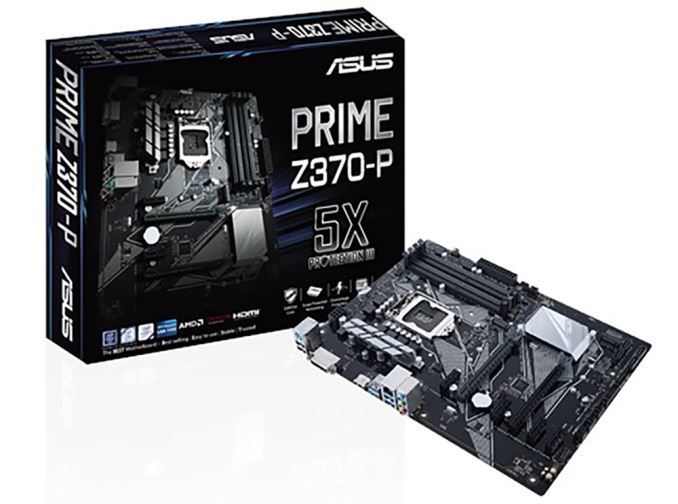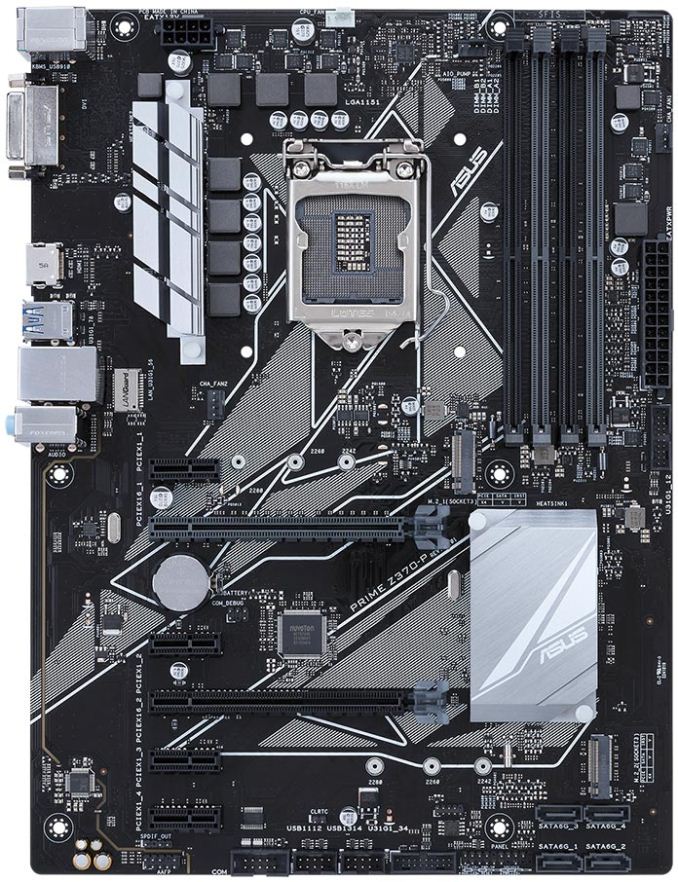Analyzing Z370 for Intel's 8th Generation Coffee Lake: A Quick Look at 50+ Motherboards
by Ian Cutress, Anton Shilov, Joe Shields & Gavin Bonshor on October 20, 2017 2:00 PM ESTASUS PRIME Z370-P
Following on from the second of two Prime branded boards at launch, the Z370-P has a completely different emphasis altogether. The priority has been shifted towards a broader focus on pure value, and the Z370-P comes in at the lowest price of all the ASUS Z370 motherboards. In comparison to the Z370-A Prime board, the Z370-P is considerably stripped down from all the bells and whistles, with this board sitting firmly on its laurels of a base Z370 motherboard but with ASUS optimizations.
This entry-level offering features a full sized ATX frame with four DIMM slots supporting up to DDR4-3866 with a maximum capacity of 64GB in total across all four DIMMs. This board is the only across the entire ASUS launched range not to feature Intel’s I219-V Gigabit network controller, instead opting for a more value orientated Realtek controller. Along with the TUF Gaming pairing, the Z370-P makes use of the more cost-effective Realtek ALC887 audio codec, and in this case, there is no EMI shielding. Dotted around the PCB, there is a dedicated header for AIO CPU cooling in addition to three 4-pin PWM compatible fan headers.
For the storage, the board uses a pair of M.2 PCIe x4 slots, with one either side of the full-length PCIe slots. This comes along with four SATA ports sticking out of the board on the bottom right. For PCIe slots, the top slot is a full-length PCIe 3.0 x16 slot whereas the second full-length slot is pulling its lanes directly from the chipset (PCIe x4). This means that only two-way Crossfire is possible using the latency added chipset based PCIe slot. The Prime Z370-P also has four PCI x1 slots in total.
The rear IO has four USB 3.1 (5 Gbps) Type-A ports and two USB 2.0 ports, and the board also has additional headers for four USB 3.1 (5 Gbps) ports and four USB 2.0 ports. The video comes via HDMI and a DVI-D port, which leaves the 2.1 audio jacks, a combination PS/2 port, and a network port.
While the Z370-P is not the most exciting board in the range, it covers the basics and users will be considering it as one of the cheapest entries into Coffee Lake and the Z370 chipset. While it has lower specifications than the Prime Z370-A, we expect it to be picked up by budget system builders using singular graphics configurations.













83 Comments
View All Comments
weevilone - Wednesday, October 25, 2017 - link
Notable that though the new boards are often very similar to their Z270 predecessors, Asus has dropped Thunderbolt 3 support from the Maximus X Hero board.masouth - Thursday, October 26, 2017 - link
ASUS ROG Z370 Maximus X Hero"....new metallic heat sinks that are an upgrade over the plastic heatsinks found on the Z270 version"
Please excuse my ignorance because I didn't own a ROG Z270 mb but...plastic HEAT SINKS? Not shrouds or decoration over a heat sink but the actual heat sinks themselves? That's either wrong, they performed their job pretty poorly, or plastic resins have advanced a lot farther in thermal conductivity (and cost for such) than I realized.
flowrush - Sunday, November 19, 2017 - link
"The other main distinguishable feature is the inclusion of integrated 802.11ac Wi-Fi with an antenna (that can only be described as a shark fin) found on the F."The above is incorrect in the article. The integrated Wi-Fi module with antenna is found on the E not the F.
Coldgame - Saturday, November 25, 2017 - link
I'm looking to build a rig with the Z370 Gaming ITX/ac, a GTX-1070 card and an Apple Thunderbolt Display.The review states:
"The key difference in the support between the two boards is going to be the Thunderbolt 3 port on the Gaming-ITX. This port supports video outputs..."
So, can anyone confirm or deny that video generated by the GTX-1070 can be output through the onboard Thunderbolt 3 port?
hanselltc - Sunday, December 3, 2017 - link
Looking forward to low-middle end mITX choices from this platform. It'll probably be paired with a 8100/8300 and be my secondary machine.Roen - Sunday, February 4, 2018 - link
Where are the 10 Gbps ports on the back? They all look like 5 Gbps ports, even the Type C.rbarak - Wednesday, February 21, 2018 - link
Is anyone using the Z370-P on Linux with two screens?I built a new machine based on the Z370-P, and both the DVI and the HDMI connected screens show the same image, and the RHEL7 setup/displays show only one Unknown Display.
I follwed the advice on stackexchange, and added this line:
$ grep GRUB_CMDLINE_LINE_DEFAULT /etc/default/grub
GRUB_CMDLINE_LINE_DEFAULT="i915.alpha_support=1"
Then I did:
sudo grub2-mkconfig -o "$(readlink /etc/grub2.conf)"
And rebooted, but still, the two displays are not shown.
dromoxen - Wednesday, May 9, 2018 - link
Shocked to see that both the Asrock mitx boards are "szie=ATX" .. LOLThe addition of Tunderbolt sure seems to add a hefty premium £120 vs £160 , luckily I can do without.
Kroebo - Sunday, October 7, 2018 - link
Sadly, I discovered that the ZUG Gaming PLUS doesn't support SLI.trag - Tuesday, January 15, 2019 - link
On the ASrock Z370M Pro4 the M.2 slot information is backwards. Both slots support NVME. One slot also supports SATA. As written, "The first M.2 slot is SATA only while the second supports PCIe." it seems to say that one slot is SATA only and the other slot is PCIe (NVME) only.